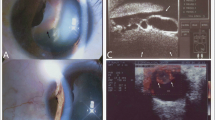Abstract
TA is a 56-year-old man who complained of a gradual distortion of the vision in his right eye over the past several months. Examination found vision in his right eye of 20/20 and in the left eye of 20/70 with his current glasses. Refraction documented an increased astigmatism of four diopters at an axis of 60°. Slit-lamp examination initially appeared unremarkable, but after dilation of the pupils, a sectorial cataract at 2:00 was noted. Fundus examination was unremarkable but the cataract blocked an adequate view of the peripheral retina and ciliary body.
You have full access to this open access chapter, Download chapter PDF
Similar content being viewed by others
Keywords
These keywords were added by machine and not by the authors. This process is experimental and the keywords may be updated as the learning algorithm improves.
TA is a 56-year-old man who complained of a gradual distortion of the vision in his right eye over the past several months. Examination found vision in his right eye of 20/20 and in the left eye of 20/70 with his current glasses. Refraction documented an increased astigmatism of four diopters at an axis of 60°. Slit-lamp examination initially appeared unremarkable, but after dilation of the pupils, a sectorial cataract at 2:00 was noted. Fundus examination was unremarkable but the cataract blocked an adequate view of the peripheral retina and ciliary body.
B-scan was performed and demonstrated a solid mass lesion in the ciliary body at the 1:00–3:00 position. It was difficult to angle the A-scan perpendicular to the tumor, but the impression was that of a medium irregularly reflective lesion with moderate spontaneous vascularity. It was highly consistent with a malignant melanoma of the ciliary body. Immersion B-scan revealed a tumor that appeared to mechanically press on the lens that was felt to explain the irregular astigmatism (Fig. 1).
Inadequate visualization of the fundus by the ophthalmoscope should prompt an echographic evaluation of the cataractous eye, especially in a patient who has not been followed over time by his doctor as the cataract progresses. The documentation of a thorough fundus examination within the past couple of years substantially reduces the chances of an unsuspected intraocular melanoma hiding behind a media opacity such as a cataract.
Author information
Authors and Affiliations
Rights and permissions
Copyright information
© 2014 Springer Science+Business Media New York
About this chapter
Cite this chapter
Harrie, R.P., Kendall, C.J. (2014). Case Study 81 Malignant Melanoma of the Ciliary Body with Lens Displacement. In: Clinical Ophthalmic Echography. Springer, New York, NY. https://doi.org/10.1007/978-1-4614-7082-3_81
Download citation
DOI: https://doi.org/10.1007/978-1-4614-7082-3_81
Published:
Publisher Name: Springer, New York, NY
Print ISBN: 978-1-4614-7081-6
Online ISBN: 978-1-4614-7082-3
eBook Packages: MedicineMedicine (R0)





